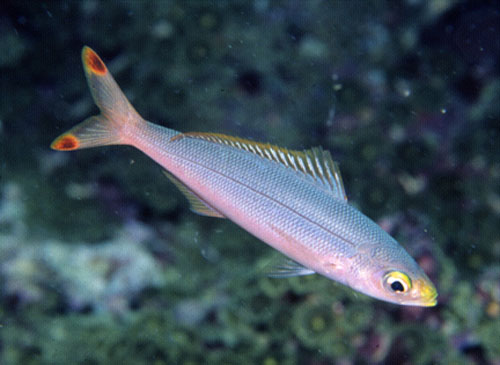| Caesionidae (Fusiliers), subfamily: Caesioninae |
| 21 cm TL (male/unsexed) |
|
reef-associated; marine; depth range 1 - 100 m, non-migratory |
| Indo-West Pacific: East Africa (excluding the Red Sea and Arabian (Persian) Gulf) eastward to Fiji. Reported from the Ryukyu Islands (Ref. 559). |
|
Dorsal spines (total): 10-11; Dorsal soft rays (total): 14-16; Anal spines: 3-3; Anal soft rays: 11-13. Variable body coloration, dark red to silvery, paler ventrally with lateral line darker; often yellowish snout and eyes. Caudal fin tips distinctly black or reddish black (Ref. 48636). 4-5 scales on cheek; 21-29 predorsal scales; scaled dorsal and anal fins. Upper peduncular scale rows usually 11 (10-12); lower peduncular scale rows usually 15 (13-17). ventrolateral surface of basioccipital with a broad process for attachment of Baudelot's ligament. Post maxillary with 2 processes; posterior end of maxilla tapered (Ref. 1723). Head length 3.0-3.5 in SL; body depth 3.6-4.8 in SL (Ref. 90102). |
| Ranges widely around coral reefs (Ref. 58652), sometimes forming schools with other Pterocaesio species. Feeds on zooplankton in midwater aggregations. Oviparous, with numerous, small pelagic eggs (Ref. 402). Also caught mostly by drive-in nets. Important tuna baitfish. |
|
Least Concern (LC); Date assessed: 09 March 2015 Ref. (130435)
|
| harmless |
Source and more info: www.fishbase.org. For personal, classroom, and other internal use only. Not for publication.

